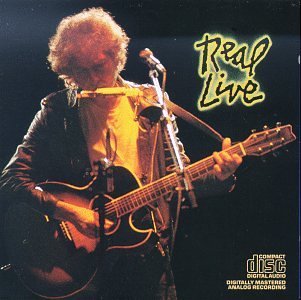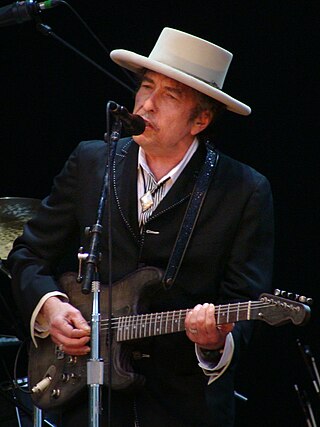
Blood on the Tracks is the fifteenth studio album by American singer-songwriter Bob Dylan, released on January 20, 1975, by Columbia Records. The album marked Dylan's return to Columbia after a two-album stint with Asylum Records. Dylan began recording the album at an A & R studio in New York City in September 1974. In December, shortly before Columbia was due to release the album, Dylan abruptly re-recorded much of the material in Sound 80 studio in Minneapolis. The final album contains five tracks recorded in New York and five from Minneapolis. The album’s songs have been linked to tensions in Dylan's personal life, including his estrangement from his then-wife Sara. One of their children, Jakob Dylan, has described the songs as "my parents talking." In interviews, Dylan has denied that the songs on the album are autobiographical.

"Blind Willie McTell" is a song written and performed by American singer-songwriter Bob Dylan. Named for the blues singer of the same name, the song was recorded in the spring of 1983, during the sessions for Dylan's album Infidels; however, it was ultimately left off the album and did not receive an official release until 1991, when it appeared on The Bootleg Series Volumes 1–3 1961–1991. It was also later anthologized on Dylan (2007).

Real Live is a live album by American singer-songwriter Bob Dylan, released on November 29, 1984, by Columbia Records. Recorded during the artist's 1984 European Tour, most of the album was recorded at Wembley Stadium on 7 July, but "License to Kill" and "Tombstone Blues" come from St James' Park, Newcastle on 5 July, and "I and I" and "Girl from the North Country" were recorded at Slane Castle, Ireland on 8 July.

The Bootleg Series Vol. 5: Bob Dylan Live 1975, The Rolling Thunder Revue is a live album by Bob Dylan released by Columbia Records in 2002. The third installment in the ongoing Bob Dylan Bootleg Series on Legacy Records, it documents the Rolling Thunder Revue led by Dylan prior to the release of the album Desire. Until the release of this album, the only official live documentation of the Rolling Thunder Revue was Hard Rain, recorded during the less critically well received second leg of the tour.
"Shelter from the Storm" is a song by Bob Dylan, recorded on September 17, 1974, and released on his 15th studio album, Blood on the Tracks, in 1975. It was later anthologized on the compilation album The Essential Bob Dylan in 2000.
"Idiot Wind" is a song by Bob Dylan, which appeared on his 1975 album Blood on the Tracks. He began writing it in the summer of 1974, after his comeback tour with The Band. Dylan recorded the song in September 1974 and re-recorded it in December 1974 along with other songs on his album Blood on the Tracks. Between the recordings, he often reworked the lyrics. A live version of the song was released on Dylan's 1976 album Hard Rain, and all of the studio outtakes from the September sessions were released on the deluxe edition of The Bootleg Series Vol. 14: More Blood, More Tracks in 2018.

Bob Dylan is an American singer-songwriter. Often considered to be one of the greatest songwriters in history, Dylan has been a major figure in popular culture over his 60-year career. He rose to prominence in the 1960s, when his songs "Blowin' in the Wind" (1963) and "The Times They Are a-Changin'" (1964) became anthems for the civil rights and antiwar movements. Initially modeling his style on Woody Guthrie's folk songs, Robert Johnson's blues, and what he called the "architectural forms" of Hank Williams's country songs, Dylan added increasingly sophisticated lyrical techniques to the folk music of the early 1960s, infusing it "with the intellectualism of classic literature and poetry". His lyrics incorporated political, social, and philosophical influences, defying pop music conventions and appealing to the burgeoning counterculture.
"With God on Our Side" is a song by Bob Dylan, released as the third track on his 1964 album The Times They Are A-Changin'. Dylan first performed the song during his debut at The Town Hall in New York City on April 12, 1963.
"Simple Twist of Fate", a song by American singer-songwriter Bob Dylan, was recorded on September 19, 1974, and was released in 1975 as the second song on his 15th studio album Blood on the Tracks.
"You're a Big Girl Now" is a song by Bob Dylan, released on his 15th studio album, Blood on the Tracks, in 1975. It is one of five songs on the album that Dylan initially recorded in New York City in September 1974 and then re-recorded in Minneapolis in December that year. The latter recording, made on December 27, 1974, became the album track.
"If You See Her, Say Hello" is a song by American singer-songwriter Bob Dylan from his 15th studio album, Blood on the Tracks (1975). The song is one of five on the album that Dylan initially recorded in New York City in September 1974 and then re-recorded in Minneapolis. The later recording, made on December 30, 1974, was produced by Dylan's brother David Zimmerman, who was not credited. The recording later became the album track and the B-side of the "Tangled Up in Blue" single, released in February 1975.
"It Takes a Lot to Laugh, It Takes a Train to Cry" is a song written by Bob Dylan, that was originally released on his album Highway 61 Revisited. It was recorded on July 29, 1965. The song was also included on an early, European Dylan compilation album entitled Bob Dylan's Greatest Hits 2.

"Watching the River Flow" is a blues rock song by American singer Bob Dylan. Produced by Leon Russell, it was written and recorded during a session in March 1971 at the Blue Rock Studio in New York City. The collaboration with Russell formed in part through Dylan's desire for a new sound—after a period of immersion in country rock music—and for a change from his previous producer.
"She's Your Lover Now" is a song written by the American singer-songwriter Bob Dylan, and recorded for his 1966 album Blonde on Blonde, but ultimately never used. It is a "dramatized scene for three players, but only one speaker – the singer – who's attempting to unravel a tangle of complicated emotions." Despite the unfinished recording, critic Greil Marcus wrote in his 1975 book Mystery Train that "thanks to a guitar note here, a piano rumble there, Dylan's bitterest lyrics, and his unforgiving vocal, it is one of the most terrifying performances ever recorded."
"Romance in Durango" is the seventh song on Bob Dylan's 1976 album Desire. It was written by Dylan and Jacques Levy, who collaborated with Dylan on most of the songs on the album. The chorus contains several lines sung in Spanish, resulting in the song being released as a single in Spain in 1977. It was also released as a b-side to the Japanese single of "One More Cup of Coffee" in 1976. The song was produced by Don DeVito.
"Born in Time" is a rock song written by American singer-songwriter Bob Dylan, who first released the track on September 10, 1990, on his twenty-seventh studio album Under the Red Sky. It is a reworking of a song originally recorded at the previous year's Oh Mercy sessions. The British recording artist Eric Clapton covered the song for his 1998 studio effort Pilgrim and released his take on the tune as a single. The song has been praised by critics for its catchy melody and romantic, dreamlike lyrics.
"You're Gonna Make Me Lonesome When You Go" is a song by Bob Dylan. Recorded in September 1974, it appeared as the fifth track on Dylan's album Blood on the Tracks, released in January 1975.
"Sara" is a song from Bob Dylan's 1976 album Desire. It is the closing song on the album. Unlike many of the songs on the album, which were written by Dylan and Jacques Levy, "Sara" was written solely by Dylan, as an autobiographical account of his estrangement from then-wife Sara Dylan. It was recorded on July 31, 1975.

The Bootleg Series Vol. 14: More Blood, More Tracks is a compilation album by American singer-songwriter Bob Dylan. The 12th installment in the ongoing Bob Dylan Bootleg Series, it was released by Legacy Records on November 2, 2018. The compilation focuses on recordings Dylan made in September and December 1974 for his 1975 album Blood on the Tracks. The release comes in both a one-disc standard edition and a six-disc deluxe edition. It is the first volume since the third where the standard edition is not a double disc.

"One More Cup of Coffee (Valley Below)" is a song by American singer-songwriter Bob Dylan, which was released as the fourth track on his seventeenth studio album Desire (1976). The song was written by Dylan, and produced by Don DeVito. The album version of "One More Cup of Coffee (Valley Below)" was recorded on July 30, 1975, and released on Desire in January 1976. Dylan said the song was influenced by his visit to a Romani celebration at Saintes-Maries-de-la-Mer in France on his 34th birthday.









